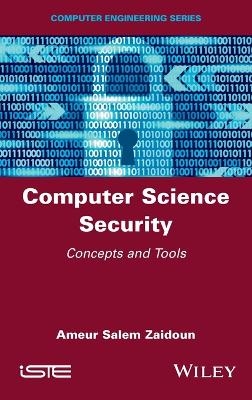
Computer Science Security
ISTE Ltd and John Wiley & Sons Inc (Verlag)
978-1-78630-755-2 (ISBN)
Computing has infiltrated all fields nowadays. No one can escape this wave and be immune to security attacks, which continue to evolve, gradually reducing the level of expertise needed by hackers.
It is high time for each and every user to acquire basic knowledge of computer security, which would enable them to mitigate the threats they may face both personally and professionally. It is this combined expertise of individuals and organizations that will guarantee a minimum level of security for families, schools, the workplace and society in general.
Ameur Salem Zaidoun received a National Diploma in Computer Engineering from ENSI, Tunisia, and is a university teacher at ISET of Siliana at the level of Lecturer Technologist. An ex-developer and security consultant, he is a CCNA R&S-, DevNet- and CCNA-Security-certified and a Huawei HCNA-R&S-certified Cisco Instructor.
List of Acronyms xi
Introduction xiii
Chapter 1 General Concepts in Security 1
1.1 Introduction 1
1.2 Reasons for security 2
1.2.1 Technical issues 2
1.2.2 Social factors 4
1.3 Security attacks 5
1.3.1 Passive/active classification of attacks 5
1.3.2 Direct/indirect classification of attacks 8
1.3.3 Examples of attacks 10
1.3.4 Some statistics 12
1.4 Security objectives 13
1.4.1 Establishing a culture 13
1.4.2 Establishing technical solutions 13
1.5 Security fields 14
1.5.1 Energy security 14
1.5.2 Organizational and physical security 15
1.5.3 Software security 16
1.6 Normalization of security 18
1.6.1 Fundamental issues and general presentation 18
1.6.2 ISO 7498-2 norm 19
1.7 Security services 24
1.7.1 Authentication 25
1.7.2 Confidentiality 27
1.7.3 Integrity 27
1.7.4 Non-repudiation 27
1.7.5 Traceability and access control 27
1.7.6 Service availability 27
1.8 Security mechanisms 28
1.8.1 Encryption 28
1.8.2 Integrity check 29
1.8.3 Access check 29
1.8.4 Electronic signature 30
1.8.5 Notarization 30
1.9 Good practices 31
1.10 Conclusion 31
Chapter 2 Security Weaknesses 33
2.1 Introduction 33
2.2 Weakness in the TCP/IP 34
2.2.1 ARPANet, the ancestor of the Internet 34
2.2.2 The Internet and security problems 34
2.2.3 The Internet and the ability to analyze 35
2.3 Weaknesses due to malware and intrusion tools 36
2.3.1 Viruses 37
2.3.2 Worms 40
2.3.3 Spam 41
2.3.4 Software bomb 42
2.3.5 Trojan horse 42
2.3.6 Spyware 43
2.3.7 Keylogger 44
2.3.8 Adware 44
2.3.9 Other malware 45
2.3.10 Comparison of intrusion tools 46
2.4 Conclusion 46
Chapter 3 Authentication Techniques and Tools 49
3.1 Introduction 49
3.2 Theoretical concepts of authentication 50
3.2.1 Identification 50
3.2.2 Authentication 51
3.3 Different types of authentications 51
3.3.1 Local service authentication 51
3.3.2 Network authentication 52
3.4 AAA service 56
3.4.1 Local AAA 57
3.4.2 Server AAA 59
3.5 Conclusion 63
Chapter 4 Techniques and Tools for Controlling Access, ACL and Firewalls 65
4.1 Introduction 65
4.2 Access control list 66
4.2.1 ACL classification 66
4.2.2 ACL configuration in Cisco 68
4.2.3 ACL configuration for Huawei 74
4.3 Firewall 78
4.3.1 Filtering function 79
4.3.2 Functionalities of tracing and NAT 81
4.3.3 Firewall architecture 82
4.3.4 How a firewall works 84
4.3.5 Firewall classifications 84
4.3.6 Stateful firewall 86
4.3.7 Zone-based firewall 87
4.3.8 Firewall examples 90
4.4 The concept of a DMZ 92
4.4.1 Implementation of topologies 92
4.5 Conclusion 95
Chapter 5 Techniques and Tools for Detecting Intrusions 97
5.1 Introduction 97
5.2 Antivirus 97
5.2.1 Functions of an antivirus 97
5.2.2 Methods for detecting a virus 98
5.2.3 Actions taken by an antivirus 98
5.2.4 Antivirus components 99
5.2.5 Antivirus and firewall comparison 99
5.3 Intrusion detection systems 100
5.3.1 IDS purposes 100
5.3.2 IDS components and functions 100
5.3.3 IDS classification 102
5.3.4 Examples of IDS/IPS 105
5.4 Conclusion 107
Chapter 6 Techniques and Tools for Encryption, IPSec and VPN 109
6.1 Introduction 109
6.2 Encryption techniques 110
6.2.1 Basic principles of encryption 111
6.2.2 Cryptoanalysis 112
6.2.3 Evolution of cryptography 113
6.2.4 The concept of certificates 117
6.2.5 Comparison of encryption techniques 118
6.3 IPSec 119
6.3.1 Ah 120
6.3.2 Esp 120
6.3.3 Different IPSec modes 121
6.3.4 Different IPSec implementations 122
6.3.5 Different IPSec encapsulations 122
6.3.6 IKE protocol 125
6.4 VPNs 126
6.4.1 Issues and justifications 126
6.4.2 VPN principles 127
6.4.3 Different types of VPNs 127
6.4.4 Different tunneling protocols 128
6.4.5 Site-to-site IPSec VPN configuration 129
6.5 Conclusion 131
Chapter 7 New Challenges and Trends in Security, SDN and IoT 133
7.1 Introduction 133
7.2 SDN security 134
7.2.1 General description of an SDN 134
7.2.2 SDN architecture 135
7.2.3 SDN components 136
7.2.4 Security issues in SDNs 138
7.2.5 Security solutions for SDNs 139
7.3 IoT/IoE security 141
7.3.1 Sensor networks 141
7.3.2 Security issues in the IoT 143
7.3.3 Blockchain: an IoT security solution 145
7.4 Conclusion 146
Chapter 8 Security Management 147
8.1 Introduction 147
8.2 Security audits 148
8.2.1 Objectives 148
8.2.2 Audit action diagram 149
8.2.3 Organizational and physical audit 150
8.2.4 Technical audit 151
8.2.5 Intrusive test 152
8.2.6 Audit methodologies 152
8.3 Security policy demonstration 155
8.3.1 Security test and evaluation 155
8.3.2 Security policy development 159
8.3.3 Elements of a security policy 161
8.4 Norms, directives and procedures 162
8.4.1 ISO 27000 norm 163
8.4.2 ISO/FDIS 31000 norm 163
8.4.3 ISO/IEC 38500 norm 164
8.5 Conclusion 164
References 165
Index 167
| Erscheinungsdatum | 05.09.2022 |
|---|---|
| Verlagsort | London |
| Sprache | englisch |
| Maße | 10 x 10 mm |
| Gewicht | 454 g |
| Themenwelt | Informatik ► Netzwerke ► Sicherheit / Firewall |
| Mathematik / Informatik ► Informatik ► Theorie / Studium | |
| ISBN-10 | 1-78630-755-3 / 1786307553 |
| ISBN-13 | 978-1-78630-755-2 / 9781786307552 |
| Zustand | Neuware |
| Haben Sie eine Frage zum Produkt? |
aus dem Bereich


